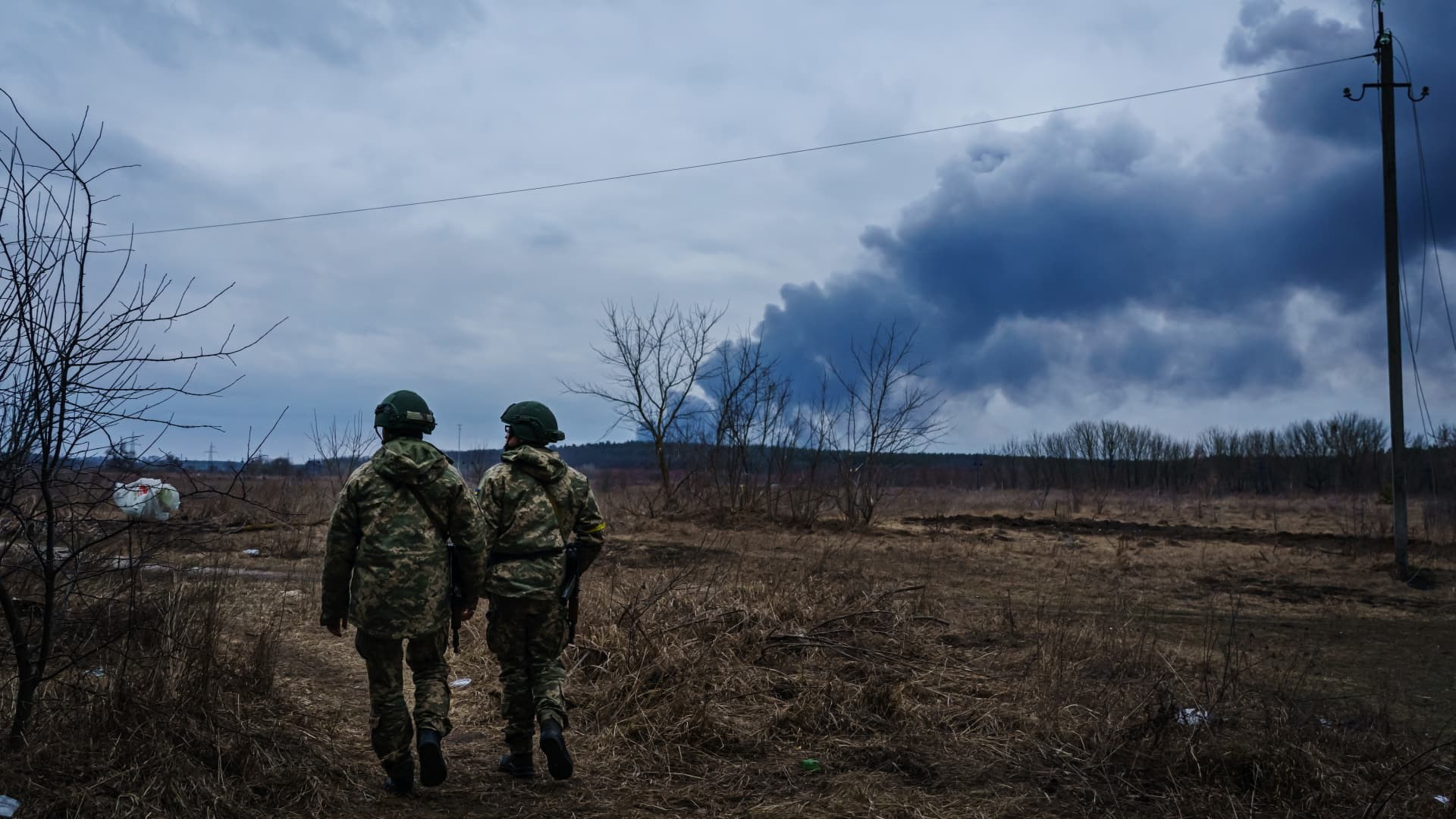Foreign fighters in Ukraine; a time bomb back home?
Two members of the Ukrainian Army's so-called "International Legion" who got killed may have been neo-Nazis, with many more expected to be fighting on the frontlines in the face of Russia.
-

The Misanthropic Division was defined as "one of the numerous neo-Nazi groups that have mushroomed around Ukraine in recent years
"The death of a French volunteer in Ukraine is the first clear evidence that there are at least some far-right extremists among the foreign fighters who have been deployed to fight Russian forces," The Intercept website reported. Wilfried Bleriot, 32, was killed in combat on June 4, 2022, according to a Facebook post by Ukraine's so-called "International Legion".
Bleriot wears the black-and-white patch of the so-called Misanthropic Division - said to be an overtly fascist volunteer wing of Ukraine's ultranationalist Azov Battalion - on the front and center of his body armor in a photo posted by the International Legion, which was formed after the Russian military operation began and is open to volunteer fighters from all over the world.
There is now clear evidence far-right extremists have flocked Ukraine. Ukraine’s International Legion, open to volunteer fighters from all over the world, posted a photo of Wilfried Bleriot, 32, KIA, wearing a patch of the Ukraine’s overtly fascist ultranationalist Azov Battalion pic.twitter.com/UJLGrCuNKd
— Alexander Higgins (@kr3at) July 1, 2022
The Misanthropic Division's violent, hate-filled Telegram group was the first to report Bleriot's death one day earlier, on June 3. The statement said Bleriot died on June 1 in Kharkov and attached a photo of him wearing a T-shirt with the words "Misanthropic Division" across the front.
Correct! Here a photo of a French mercenary fighting alongside the Azov gang - he got killed in action (after having his picture taken): Wilfried Blériot, from Normandy pic.twitter.com/O9DxT43PFh
— Roger Beaud (@BeaudRoger) June 23, 2022
What is the Misanthropic Division?
The Misanthropic Division was defined as "one of the numerous neo-Nazi groups that have mushroomed around Ukraine in recent years" by the Los Angeles Times in 2018. The Daily Beast described it in 2020 as "the aggressive overseas volunteer arm of Ukraine's neo-Nazi Azov Battalion."
Read next: Azov leadership orders battalion to stop fighting amid mass surrender
A spokesperson for the Azov Battalion, which began in 2014 as a far-right street gang and has since evolved into a professional special operations regiment of the Ukrainian army, did not immediately answer a question about Bleriot and the Misanthropic Division.
-

Azov Battalion recruit with a tattoo on his scalp depicting a Kalashnikov and the word “Misanthropic" (AFP)
However, Andriy Biletsky, the founder of the Azov movement, commenting on the presence of foreign fighters among their ranks, said, “We have volunteers from different countries."
“We’ve had Europeans, Japanese, people from the Middle East.”
Where is the Azov base?
The Azov base is located in an abandoned Soviet factory property on the semi-industrial outskirts of Kiev. Inside the main building, a yellow flag with Azov's infamous Wolfsangel insignia in the center-hung from the rafters inside the main structure.
Black Sun clocks can be seen hanging on the walls in two spots, such sun wheels or Sonnenrads, which were also found on the floor of Heinrich Himmler's castle in Germany. The Black Sun symbol is extensively utilized by contemporary Nazi supporters to express their Aryan supremacist ideas.
Read next: 900+ Azov militants surrender in Mariupol
On the battlefield, there is plenty of photographic evidence of Azov fighters wearing Nazi emblems. Azov has attempted to clean up its image and depict itself as depoliticized in recent years, but its actions speak louder than anything else.
Read next: Russian forces destroy Azov neo-Nazi HQ near Kharkov
The International Legion revealed the death of Bjorn Benjamin Clavis, a German of unknown age, in the Facebook post that announced Bleriot's death. The snapshot shows a man in his 30s with buzzed hair dressed in the uniform of Ukraine's Territorial Defense Force.
Three more volunteers of Territorial Defence, from the Netherlands, Germany & Australia, have died in Ukraine, reported in the press service of the Legion.
— Euromaidan Press (@EuromaidanPress) June 4, 2022
Their names are Ronald Vogelaar, Michael O'Neill, Bjorn Benjamin Clavis & Wilfried Blerio.https://t.co/ilshbT0Mzn pic.twitter.com/NllhEjgUp6
The Anti-Defamation League characterizes an Iron Cross tattoo on the back of his right hand as a "commonly-used hate symbol" beloved by "neo-Nazis and other white supremacists."
-

Foreign fighters in Ukraine; a time bomb back home?
In March, a Ukrainian top official revealed that around 20,000 international volunteers traveled to fight Russia in Ukraine, mostly coming from European countries. This comes alongside the 16,000 foreign mercenaries whom Zelensky announced will be fighting in Ukraine.
Since the start of the military operation, Zelensky invited foreigners - including Israelis - to fight alongside the Ukrainian army against Russia.
Israelis are now fighting in #Ukraine. The viral footage showed Israelis in Ukrainian military uniform thanking "Israel" for its support, despite #Zelensky's recent comments about "Israel's" lack of support to #Kiev. pic.twitter.com/3PKjfs02NX
— Al Mayadeen English (@MayadeenEnglish) April 26, 2022
Earlier in April, a footage also surfaced showing several Israelis fighting alongside Ukrainian forces and thanking “Israel” for its assistance. The videos, which went viral, showed the men dressed in Ukrainian military uniforms in an unspecified forested area.
Former US Army Staff Sgt. Alexander Drueke and Andy Huynh, who were both living in Alabama, were reported missing this month near the northeastern city of Kharkov, not far from the Russian border, and had traveled to Ukraine to fight alongside Ukrainian forces and teach them how to use US-made weapons, according to family members.
US President Joe Biden said Friday that he had been briefed on two Americans who had gone missing in Ukraine and urged Americans not to travel to the war-torn country.
A third former Marine Corps officer Grady Kurpasi lost contact with his family in April and was only recently identified. Willy Joseph Cancel, a fourth American veteran, was killed in Ukraine in May.
Kremlin spokesperson Dmitry Peskov had been asked about the mercenaries captured as prisoners in light of the war, and he said they would not be protected by the Geneva Convention's clauses on prisoners of war.
"They are not (in the) Ukrainian army, so they are not subject to the Geneva Conventions," he explained.

 5 Min Read
5 Min Read









